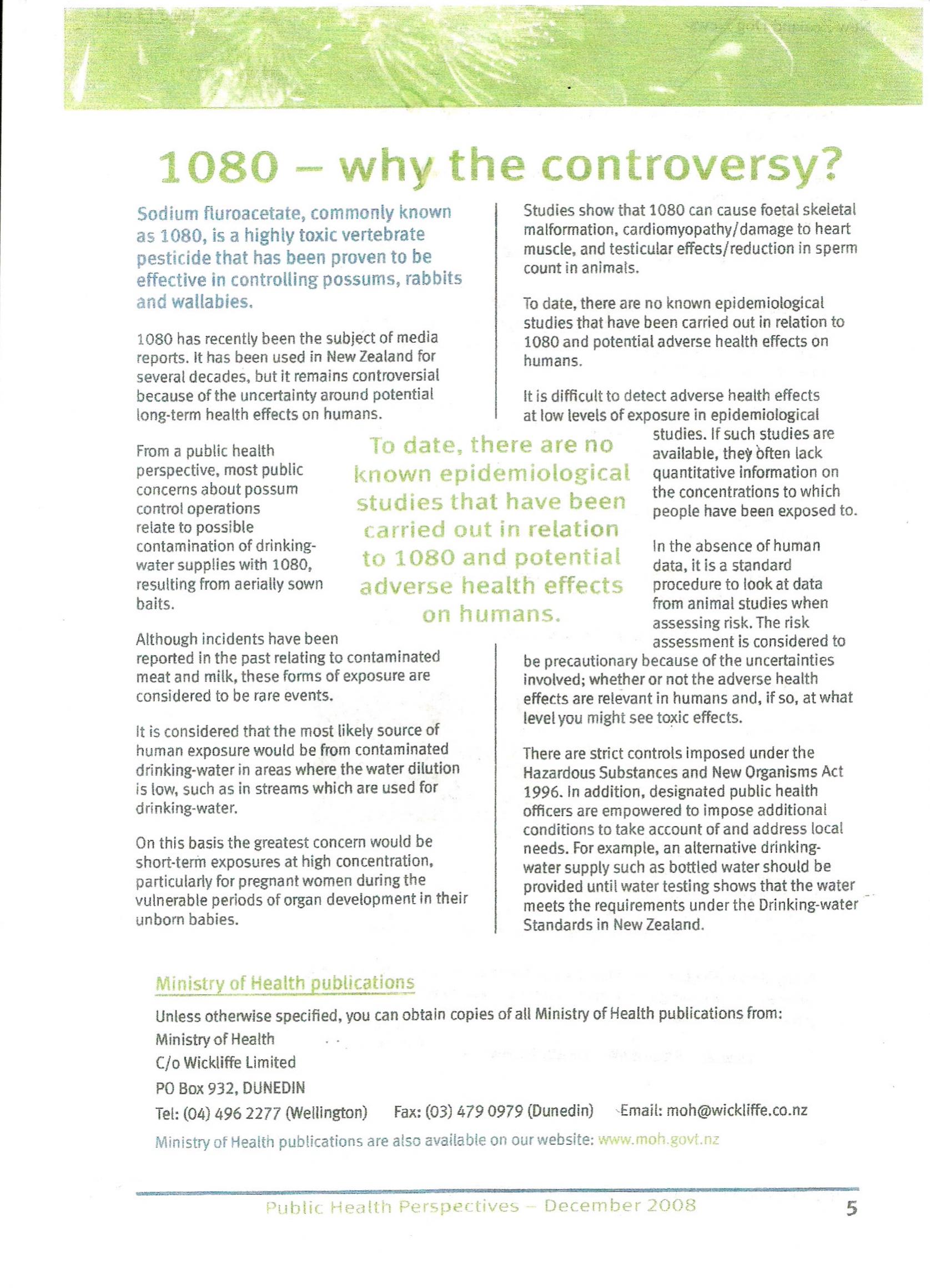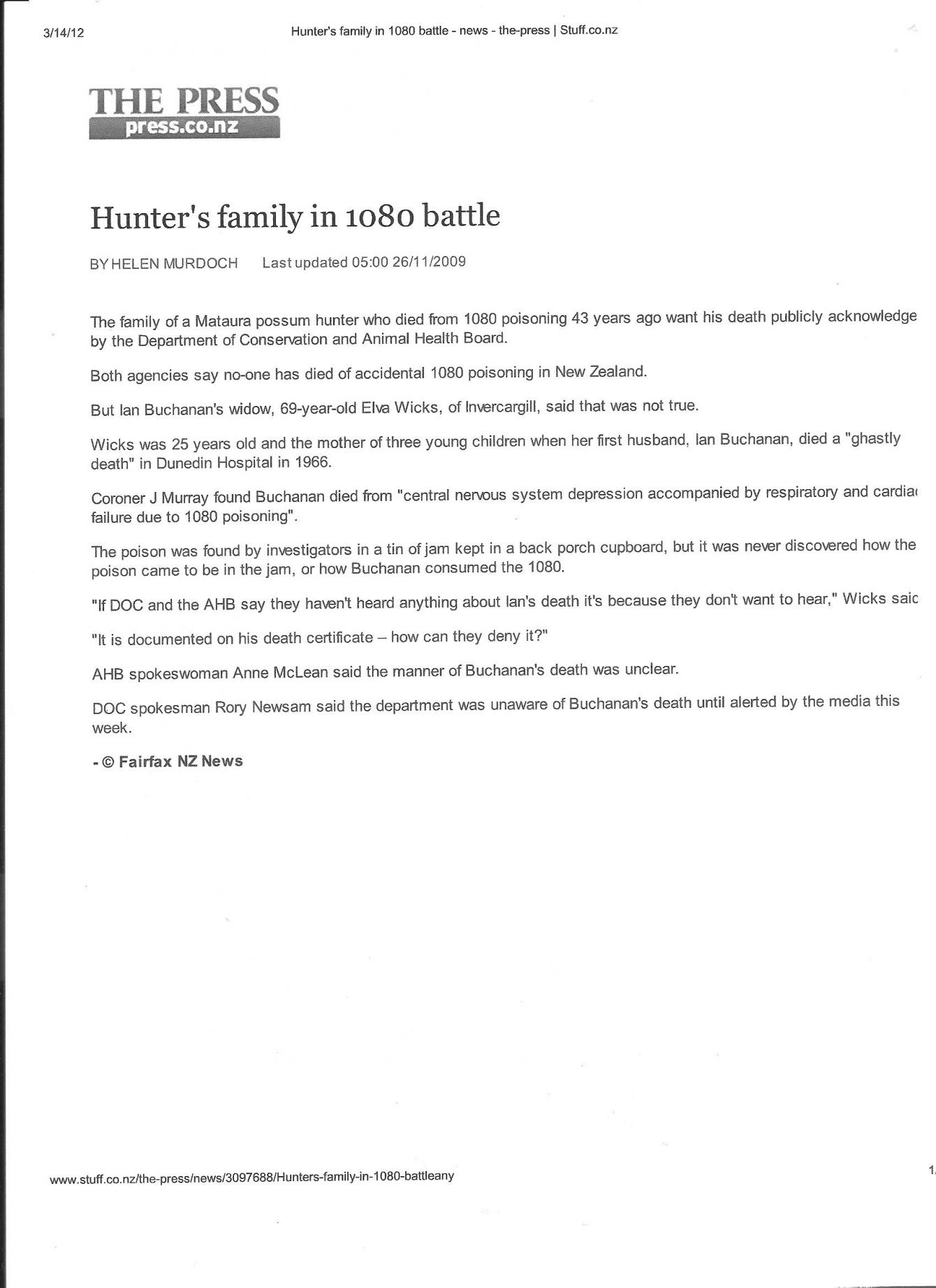Well done Aly.
Welcome guest, is this your first visit? Create Account now to join.
Welcome to the NZ Hunting and Shooting Forums.
Search Forums
User Tag List
+ Reply to Thread
Results 76 to 90 of 248
Thread: 1080 KILLING FISH
Hybrid View
-
01-10-2014, 06:30 AM #1OPCz


- Join Date
- Jun 2012
- Location
- Nor West of Auckland on the true right of the Kaipara River
- Posts
- 34,713
It takes 43 muscle's to frown and 17 to smile, but only 3 for proper trigger pull.
What more do we need? If we are above ground and breathing the rest is up to us!
Rule 1: Treat every firearm as loaded
Rule 2: Always point firearms in a safe direction
Rule 3: Load a firearm only when ready to fire
Rule 4: Identify your target beyond all doubt
Rule 5: Check your firing zone
Rule 6: Store firearms and ammunition safely
Rule 7: Avoid alcohol and drugs when handling firearms
-
01-10-2014, 08:04 AM #2Member

- Join Date
- Jul 2013
- Location
- Tasman
- Posts
- 1,894
Good post Aly.
-
01-10-2014, 08:48 AM #3
-
01-10-2014, 09:08 AM #4sturg4

- Join Date
- Dec 2011
- Location
- Whakatete Bay... Coromandel
- Posts
- 1,031
DOC knows best. The buffer zone on streams have recently been removed so they can sow directly into them now. I noted a few years ago that DOC had began to refer to trout as the possums of the waterways.
This was about the time DOC had applied for a resource consent to use the poison Rotenone to kill trout in the Wellington Catchment.Last edited by Scribe; 01-10-2014 at 09:15 AM.
-
01-10-2014, 09:26 AM #5sturg4

- Join Date
- Dec 2011
- Location
- Whakatete Bay... Coromandel
- Posts
- 1,031

Time to be frightened when they remove the buffer zones from around our waterways.
-
04-10-2014, 02:48 PM #6sturg4

- Join Date
- Dec 2011
- Location
- Whakatete Bay... Coromandel
- Posts
- 1,031
-
01-10-2014, 10:51 AM #7
I think the buffer zones are imaginary anyway.
"Thats not a knife, this is a knife"
Rule 2: Always point firearms in a safe direction
CFD
tps://www.timeanddate.com/countdown/generic?iso=20180505T00&p0=264&msg=Dundees+Countdo wn+to+Gamebird+Season+2018&font=cursive
-
01-10-2014, 11:05 AM #8sturg4

- Join Date
- Dec 2011
- Location
- Whakatete Bay... Coromandel
- Posts
- 1,031
You are right 'Dundee' when we investigated the rivers after a drop even the ones with Buffer Zones we always found 1080 pellets in them.
But we still regard the removal of 'Buffer Zones' from around catchments from which water supplies are drawn as a rather sinister new development. About 4 % of all streams sampled contain more than the maximum allowable dose of 1080 in them.
Its a sort of a lottery for anyone living close to a drop zone whether you get a shot of 1080 or not.
-
01-10-2014, 11:08 AM #9
They don't exist - correct Dundee. just look at the provided GPS data points for overflight with a overlay of waterways on Google and you'll see tributary and small stream as well as many larger ones in the paths of over flight. We all know how the monsoon delivery system works - spring and sling as the chopper pilots refer to it (or at least my mate who is now flying up on the oil rigs in the UK did). 100m to the edge of the target zone is minimal margin area as has been proven over the years.
I know DOC and E-pro will say that video of pellets in the waterways have been planted there, but who provides oversight of this program at a Governmental level DOC or MOH anyway? surely they need to provide proof as to steps taken to mitigate effects etc...for reviews of funding, resource consents and the like. I know if I did something on my land I'd be up the wazoo with red tape and inspections...
Buffer zones will mean bugger all to migratory aquatic species that forage en-route in the waterways eating tasty items such as snails, koura and other aquatic items, and one good downpour can relocate fish kilometers down stream not to mention their own migratory patterns.
-
01-10-2014, 01:31 PM #10Member

- Join Date
- Jun 2014
- Location
- CNI
- Posts
- 5,997
You're right CD. What is happening and unrecognised by DoC and the Animal Health Board aka TB Free NZ and the Regional Councils which issue the poison consents is that the food chain ,especially the upper tiers which include predatory birds such as Morepork, Heron, Kingfisher, kaka, Kea, Weka, Falcon, Harrier, Pukeko, Blue and Grey ducks, all normally have to work quite hard for their prey / tucker-- Prey food such as rats, mice, nymphs and worms and insects.
What happens when 1080 is dropped in their environment is the rapid creation of a banquet of poisonous tucker, half dead or dead, very easy to catch and then eat. There is absolutely zero protection for these precious non target creatures to prevent them from consuming and dying from poisoned natural foods.
The removal of buffer zones virtually guarantees that the aquatic parts of the eco-system are condemned to the same poisonous exposure as the dry land and forest dwelling species.
The aftermath of polluted and toxic waste on land and in waterways is guaranteed and lasts many months.
Responsible management? I think not.
In the long run, trapping is safer and efficient and cheaper with many social benefits.
-
01-10-2014, 01:46 PM #11OPCz


- Join Date
- Jun 2012
- Location
- Nor West of Auckland on the true right of the Kaipara River
- Posts
- 34,713
Woody the ears of officialdom are deaf and its eyes are blind. It will take a human death before any government departments will adopt different views.
It takes 43 muscle's to frown and 17 to smile, but only 3 for proper trigger pull.
What more do we need? If we are above ground and breathing the rest is up to us!
Rule 1: Treat every firearm as loaded
Rule 2: Always point firearms in a safe direction
Rule 3: Load a firearm only when ready to fire
Rule 4: Identify your target beyond all doubt
Rule 5: Check your firing zone
Rule 6: Store firearms and ammunition safely
Rule 7: Avoid alcohol and drugs when handling firearms
-
01-10-2014, 04:04 PM #12sturg4

- Join Date
- Dec 2011
- Location
- Whakatete Bay... Coromandel
- Posts
- 1,031
-
01-10-2014, 07:03 PM #13sturg4

- Join Date
- Dec 2011
- Location
- Whakatete Bay... Coromandel
- Posts
- 1,031
 Despite the Medical Report and the Death Certificate many Government Agencies still claim there has never been a death from 1080 poisoning in NZ.
Despite the Medical Report and the Death Certificate many Government Agencies still claim there has never been a death from 1080 poisoning in NZ.
It suits them to claim there has never been a death but in doing so they deny the truth and cause the victims family a lot of grief.
We should not be surprised they act this way as many of the facts surrounding 1080 are very unpalatable and the urge to suppress them is growing greater day by day.
-
01-10-2014, 01:57 PM #14
Any one know where the bloody factory is or is that Top Secret?
"Thats not a knife, this is a knife"
Rule 2: Always point firearms in a safe direction
CFD
tps://www.timeanddate.com/countdown/generic?iso=20180505T00&p0=264&msg=Dundees+Countdo wn+to+Gamebird+Season+2018&font=cursive
-
01-10-2014, 03:59 PM #15sturg4

- Join Date
- Dec 2011
- Location
- Whakatete Bay... Coromandel
- Posts
- 1,031
Similar Threads
-
1080 Poison
By kawekakid in forum FishingReplies: 19Last Post: 18-12-2014, 09:35 PM -
Rem Mag Killing Power
By Fisherman in forum ShootingReplies: 22Last Post: 26-02-2013, 08:17 PM
Tags for this Thread
Welcome to NZ Hunting and Shooting Forums! We see you're new here, or arn't logged in. Create an account, and Login for full access including our FREE BUY and SELL section Register NOW!!





 128Likes
128Likes LinkBack URL
LinkBack URL About LinkBacks
About LinkBacks



 Reply With Quote
Reply With Quote



Bookmarks